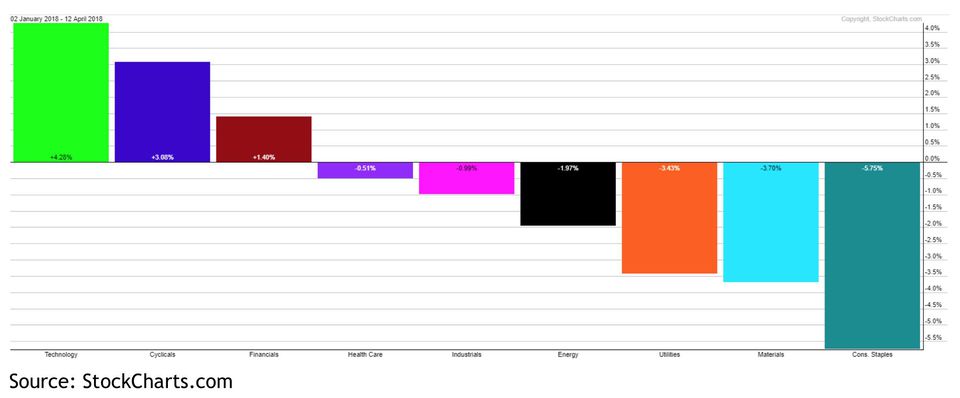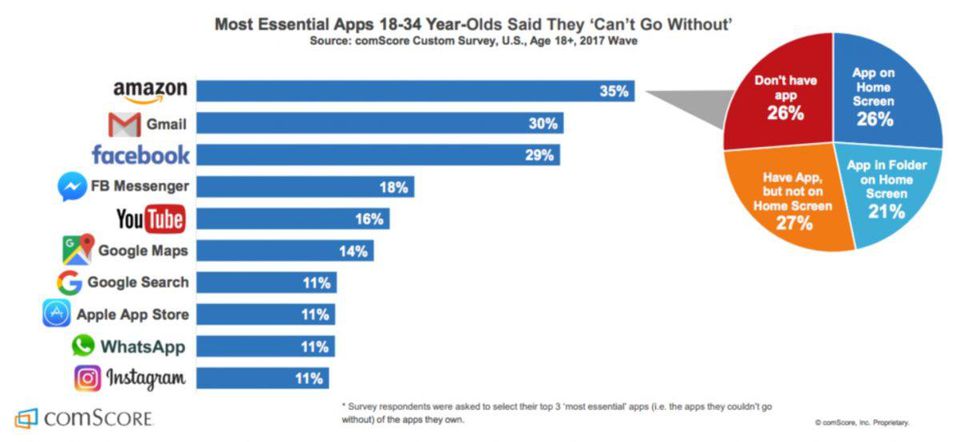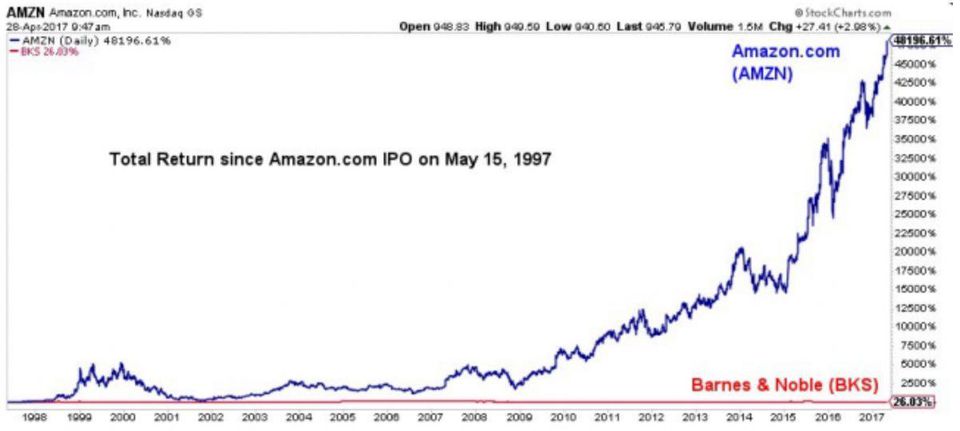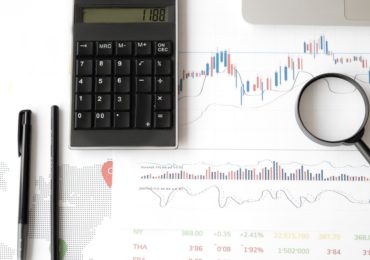 StockCharts.com
StockCharts.com
Have you ever looked at the Standard & Poor’s 500 or the Dow Industrials, and compared their performance with your own portfolio, only to be disappointed by your results?
Yes, that happens to all of us. That’s because within these broad indexes are sectors, industries, and hundreds of stocks that make up the performance of the indexes. The global economy is complex and at various times, certain sectors perform better than others, due to the unique dynamics affecting sector profitability. As investors, we want to take advantage of bull markets and maximize our portfolio profits. If the market is heading higher, we want to buy stocks within sectors that are performing the best.
The chart below shows year-to-date performance for the nine major sectors in the stock market. So far, consumer cyclicals and technology are leading the way, with consumer cyclicals up 4.28 percent and technology up 3.08%. Meanwhile the S&P 500 declined 1.18%.
The fact that consumer cyclicals and technology are leading sectors should fascinate all the finance nerds that study business/economic cycles. Both consumer cyclicals and technology tend to outperform during early expansionary phases after a recession. However, the U.S. economy is in the ninth year of its recovery since the Great Recession.
 StockCharts.com
StockCharts.comThe consumer cyclical sector, also referred to as the consumer discretionary sector, contains a wide range of industries, including automotive, consumer durables, apparel, hotels, restaurants, leisure, media, and retailing. Amazon almost single-handedly carried the consumer discretionary sector, with the e-commerce giant having 20 percent weight in the index and a year-to-date gain of 23%.
If there is one thing investors can thank the Millennials for, it’s the performance of Amazon’s stock price over the years. Millennials have become the largest generation in the U.S. and are beginning to exert more influence when it comes to buying decisions around the world. Research from comScore, a market analytics company, shows that if there is one app Millennials can’t live without, it’s Amazon. Global marketing consultancy Prophet commented that Amazon not only “makes my life easier” but also “delivers a consistent experience.”
In addition to Amazon, apparel stocks, led by Nike and Lululemon, have been strong sector performers. Trendy activewear is sweeping the casual attire world, with yoga pants and exclusive sneaker instrumental to activewear’s success.
The consumer cyclical sector, also referred to as the consumer discretionary sector, contains a wide range of industries, including automotive, consumer durables, apparel, hotels, restaurants, leisure, media, and retailing. Amazon almost single-handedly carried the consumer discretionary sector, with the e-commerce giant having 20 percent weight in the index and a year-to-date gain of 23 percent.
If there is one thing investors can thank the millennials for, it’s the performance of Amazon’s stock price over the years. Millennials have become the largest generation in the U.S. and are beginning to exert more influence when it comes to buying decisions around the world. Research from comScore, a market analytics company, shows that if there is one app millennials can’t live without, it’s Amazon. Global marketing consultancy Prophet commented that Amazon not only “makes my life easier” but also “delivers a consistent experience.”
In addition to Amazon, apparel stocks, led by Nike and Lululemon, have been strong sector performers. Trendy activewear is sweeping the casual attire world, with yoga pants and exclusive sneaker instrumental to activewear’s success.
 Comscore
ComscoreWe all know that Millennials – and to be honest, most Boomers – can’t live without their smart phones. The tech sector’s leadership in 2018 is largely attributed to mega-cap stocks such as Nvidia, Microsoft, Adobe, and Apple. The stock that stands out the most among these four companies is Nvidia. Nvidia’s stock can be described as a “Ten Bagger,” a term coined by Peter Lynch in his book “One Up on Wall Street.” It applies to investments that appreciate tenfold.
Between 2015 and 2018, Nvidia soared from the mid-$20s to north of $200 with much of its growth fueled by the cryptocurrency mania. If cryptocurrencies were gold during the California Gold Rush then Nvidia is the one selling all the pickaxes. Cryptocurrencies need to be mined, a process of using computers to perform complex calculations, and miners are rewarded with cryptocurrencies if they complete the calculations. Graphic cards are instrumental in mining cryptocurrencies and Nvidia makes one of the highest quality graphic cards.
Let’s look at some of the laggards. Consumer staples declined to the tune of 5.75% so far this year. This sector holds all the stocks my grandmother used to love talking about. The pack leader of these old-timer stocks is Proctor & Gamble, which led the move lower in 2018. There are two factors leading to P&G’s underperformance. One of these is affecting the entire consumer staples sector and the other is P&G specific.
The entire sector has been negatively impacted by higher interest rates. On top of that, P&G has been delivering lackluster revenue growth for many years. Investors have been piling into defensive stocks for their safe dividends and P&G benefited from this trend. However, things are changing. With interest rates moving higher since mid-2017, P&G’s % dividends pale in comparison with 10-year U.S. bonds yielding 2.6%. On top of that, P&G has failed to grow its core business organically in more than a decade.
P&G’s largest competitor, Unilever, has been taking market share in recent years. To make matters worse, Amazon, with private label lines and “Amazon Choice” products has Millennials favoring household goods with prime delivery over P&G products. We try our best to not make predictions here but if Amazon is in your line of business, it may spell trouble. Remember Barnes & Noble? Neither do we.
 StockCharts.com
StockCharts.comJoining Consumer Staples as one of the worst performers is the materials sector, down -3.70% in 2018. The materials sector consists of companies engaged in the extraction and refinement of chemicals, metals, and construction materials. Companies in this sector rely heavily on global economic activity. These firms took a hit recently as trade concerns escalate between the U.S. and China. DowDuPont, the world’s largest chemical company, carries a 22% weighting in materials sector and the stock is down 4.2% in 2018.
However, the biggest contributor to material’s negative performance is global paint giant Sherwin-Williams. Sherwin-Williams is down 22.13% this year. The paint maker is negatively affected by rising interest rates and recent tax reforms. Investors fear a combination of higher mortgage rates and fewer tax incentives for home ownership will hurt U.S. real-estate market and reduce demand for Sherwin-Williams paint.
So what’s the upshot? While it’s sometimes clear why certain companies suffer declines in revenue, earnings or share price, it’s not easy to spot the beginning of a new rally. In other words, bailing out of a stock or sector may seem like a good way to protect your capital, but you have to be right twice: When you sell, and when you buy again. By owning a basket of stocks and bonds, you capture all the top performers- even when you (or the guru class) were unable to forecast sector strength.







